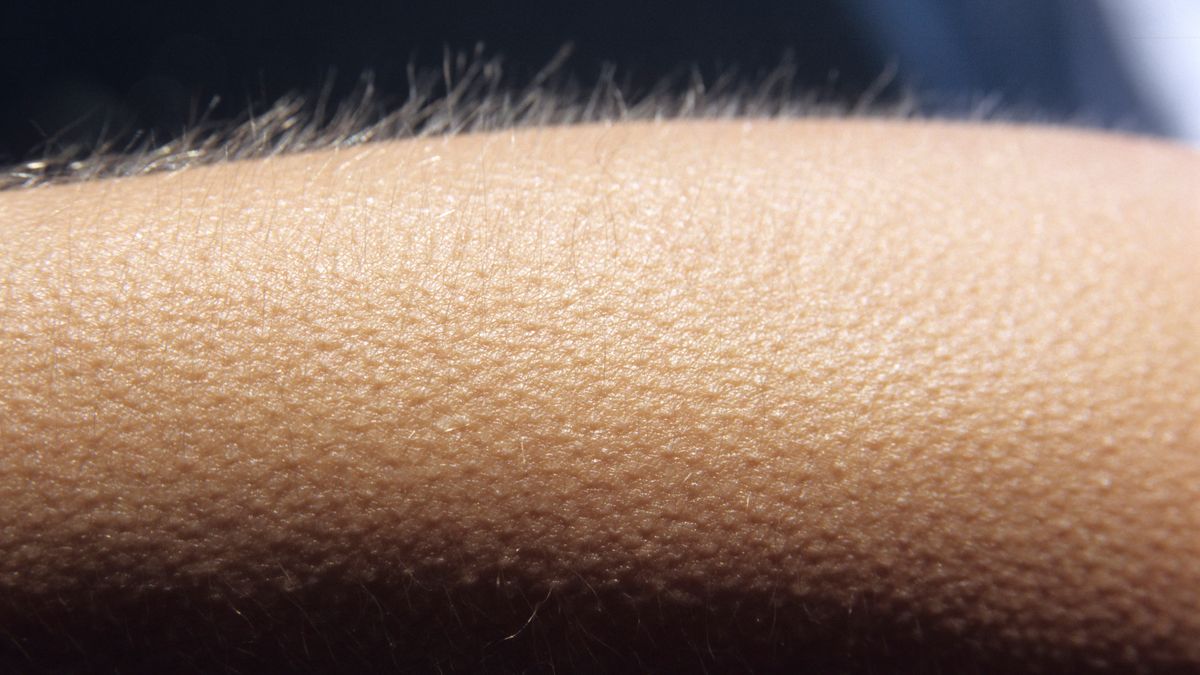
Why do we get goosebumps?
You can thank our mammalian ancestors.

You're walking home at dusk and shiver when a chilly breeze whooshes down the street. The hairs on your arms stand on end, and tiny bumps appear. This physical reaction is common when we're cold, scared or even inspired. But why do we get goosebumps?
While there are several possible explanations for why our bodies can become prime territory for goosebumps — a term that gets its name from the textured skin of a plucked goose — scientists do understand the mechanism that causes goosebumps to arise.
Below the skin are thousands of tiny muscles called arrector pili — one for each hair on the body. Nerves coiled around the arrector pili transmit electrical signals that tell the muscles when to contract. When that happens, the muscles raise their attached hairs, forming a goosebump.
Related: Why do we shiver when we're cold?
Goosebumps don't serve a clear purpose in humans, but the ability to raise body-hair comes in handy for most long-haired mammals, according to a 2014 paper in the journal Folia Primatologica. (Birds and reptiles also experience piloerection — but in these animals, the reaction raises their feathers or scales). Piloerection serves the purpose of fluffing up fur and feathers and forming a thick layer of insulation to protect them from the elements.
When furry animals feel threatened, this extra fur makes them look larger to potential aggressors, said Thomas Schubert, a psychologist at the University of Oslo in Norway, who has co-authored studies on the relationship between goosebumps and emotion. Think about what happens when your dog hears a delivery person approach the door. Your pet barks, of course, but their hackles — the hairs on the back of their neck — might stand on end. Many other mammal species, including chimpanzees — one of humans' closest primate relatives — have this same response to fear or aggression, according to the Folia Primatologica article. But because humans' body hair is sparse, "fluffing up" doesn't offer much of an advantage.
"For us humans, it really doesn't do anything to protect us," said Amy Paller, the chair of dermatology at Northwestern University's Feinberg School of Medicine. But based on the fact that piloerection exists across nearly all mammals, as well as many reptiles and birds, scientists believe that this trait was present in the very earliest mammal, according to the Folia Primatologica article. It was passed down to primates, who emerged just before or after the dinosaurs went extinct around 66 million years ago, and then stuck around in humans, despite the fact that it doesn't do much for us. It's an example of a vestigial trait, a characteristic that was useful in our long-haired ancestors and never disappeared. Other examples of vestigial traits in humans include the tailbone and the appendix.
Sign up for the Live Science daily newsletter now
Get the world’s most fascinating discoveries delivered straight to your inbox.
"Humans have a lot of traits that don't do anything anymore," Schwartz said. "It's just a relic from our mammalian ancestors."
Of course, we don't experience goosebumps only when we're cold or scared. We also get them when we experience other strong emotions, such as when we see our children walk across the stage at graduation or we read a poignant poem. That reaction likely occurs when our nervous system kicks into gear, Schubert said. Think about how your heart pounds both when you're afraid and when you're excited; in both cases, your nervous system is activated. Similarly, the nerves wrapped around those arrector pili muscles don't care if you're scared, excited or moved; they're just receiving a flood of chemical signals from the brain.
Another possible explanation posits that goosebumps might stimulate new hair growth. In 2020, a team of scientists took skin samples from mice and removed the nerves that wrap around the arrector pili. Their results, published in the journal Cell, showed that hair follicle stem cells, the cells that produce hair, were slower to activate and that new hair took longer to grow.
Using an imaging technique called electron microscopy, the scientists found that these nerves were intertwined with both the arrector pili and hair stem cells. Based on these results, the researchers proposed that piloerection allows animals to grow more fur in response to cold — another potential reason why this trait was passed down across nearly all mammal species.
In the end, those goosebumps that appear on a chilly walk home don't do much to keep you warm. Instead, they're a reminder of the family ties between us and our mammalian, avian and reptilian cousins.
Originally published on Live Science on Dec. 18, 2012 and rewritten on July 18, 2022.

Isobel Whitcomb is a contributing writer for Live Science who covers the environment, animals and health. Her work has appeared in the New York Times, Fatherly, Atlas Obscura, Hakai Magazine and Scholastic's Science World Magazine. Isobel's roots are in science. She studied biology at Scripps College in Claremont, California, while working in two different labs and completing a fellowship at Crater Lake National Park. She completed her master's degree in journalism at NYU's Science, Health, and Environmental Reporting Program. She currently lives in Portland, Oregon.










